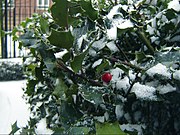Holly
| Ilex subsp. var. | ||||||||||||||||||||||||||||||||||||||||||||||||||||||||
|---|---|---|---|---|---|---|---|---|---|---|---|---|---|---|---|---|---|---|---|---|---|---|---|---|---|---|---|---|---|---|---|---|---|---|---|---|---|---|---|---|---|---|---|---|---|---|---|---|---|---|---|---|---|---|---|---|

|
|
| ||||||||||||||||||||||||||||||||||||||||||||||||||||||
| ||||||||||||||||||||||||||||||||||||||||||||||||||||||||
Holly (Ilex, pronounced /ˈaɪlɛks/)[1] is a genus of approximately 600 species of flowering plants in the family Aquifoliaceae, and the only living genus in that family.

Holly berries are somewhatTemplate:Clarify toxic and will cause vomiting and/or diarrhea when ingested by people, partly due to the ilicin content. The fatal dose is estimated to be around twenty berries for adults. However they are extremely important food for numerous species of birds, and also are eaten by other wild animals. In the fall and early winter the berries are hard and apparently unpalatable. After being frozen or frosted several times, the berries soften, and become milder in taste. During winter storms, birds often take refuge in hollies, which provide shelter, protection from predators (by the spiny leaves), and food. The flowers are sometimes eaten by the larva of the Double-striped Pug moth (Gymnoscelis rufifasciata). Other Lepidoptera whose larvae feed on holly include Bucculatrix ilecella (which feeds exclusively on hollies) and The Engrailed (Ectropis crepuscularia). Holly is commonly referenced at Christmas time. Also see: wreath for information on how the holly plant is used in Christmas wreaths.
Having evolved numerous species that are endemic to islands and small mountain ranges, and being highly useful plants, many hollies are now becoming rare. Tropical species are especially often threatened by habitat destruction and overexploitation, and at least two have become extinct, with numerous others barely surviving.[2]
| Standard Cyclopedia of Horticulture |
|---|
|
{{{1}}} The above text is from the Standard Cyclopedia of Horticulture. It may be out of date, but still contains valuable and interesting information which can be incorporated into the remainder of the article. Click on "Collapse" in the header to hide this text. |
Three species are used as stimulants and tea subsitutes- Ilex guayusa, Ilex paraguariensis and Ilex vomitoria.
Cultivation
Propagation
Pests and diseases
Species
Selected species:
| Standard Cyclopedia of Horticulture |
|---|
|
{{{1}}} The above text is from the Standard Cyclopedia of Horticulture. It may be out of date, but still contains valuable and interesting information which can be incorporated into the remainder of the article. Click on "Collapse" in the header to hide this text. |
Gallery
References
- ↑ Sunset Western Garden Book, 1995:606–607
- ↑ International Union for the Conservation of Nature and Natural Resources (IUCN) (2007): 2007 IUCN Red List of Threatened Species: Ilex
- ↑ Template:Cite paper
- ↑ Ulloa Ulloa & Jørgensen (1993), eFloras.org (2007a, b), IUCN (2007), RBGE (2007), USDA (2007a, b)
- Standard Cyclopedia of Horticulture, by L. H. Bailey, MacMillan Co., 1963







